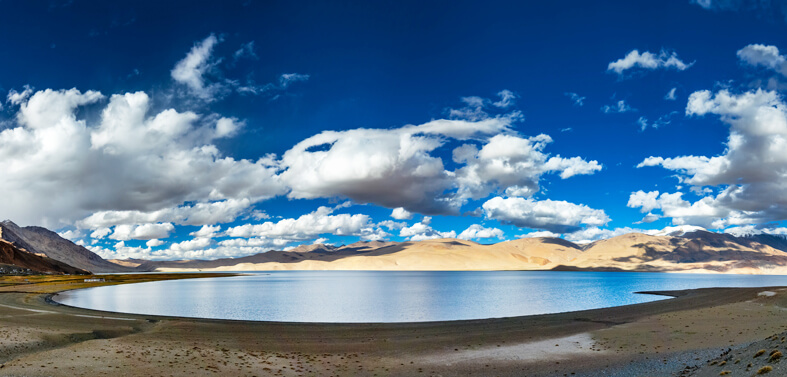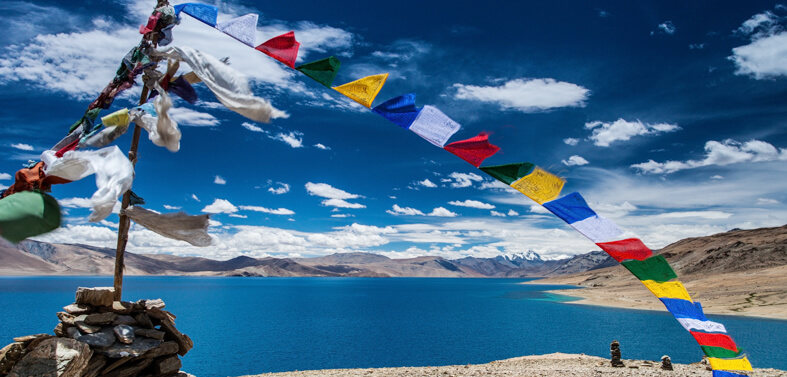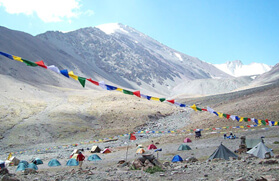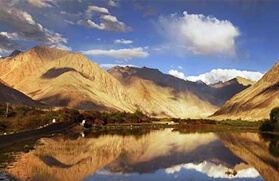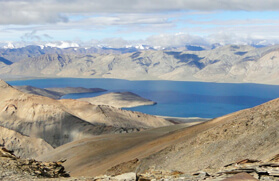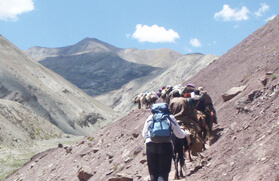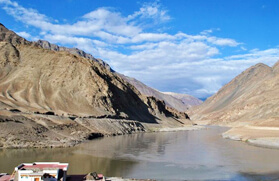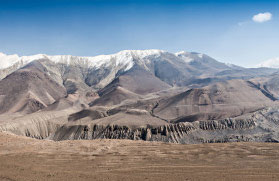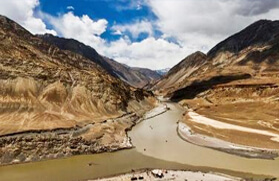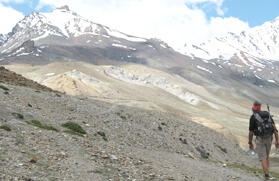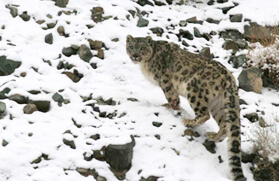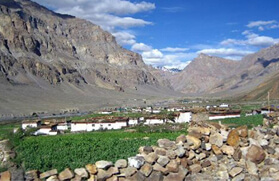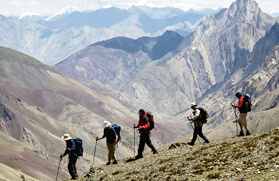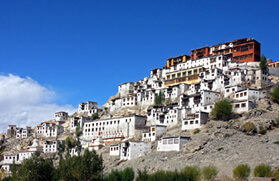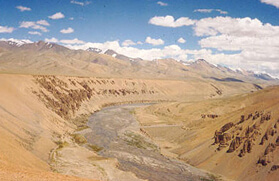Tsomoriri Lake Trekking Tour
With snow covered peaks, pleasing alpines, unproductive landscape and blue water, Ladakh is one of the famous trekking destinations across the globe. It has given origin to many beautiful lakes. Out of all, the most inspiring lake is Tsomoriri Lake also known as "Mountain Lake". It is also counted as the largest lake among all high altitude lakes of India. Tsomoriri Lake extends from the western Tibet to the eastern Ladakh. With maximum depth of 248 feet, Tso Moriri Lake is bordered by barren hills, with the scenery of beautiful snowy mountains.
This lake is acknowledged for varying its turquoise blue color with the change in light. It is enclosed with many beautiful landscapes. Tsomoriri lake trekking tour can offer you a lifetime experience along with the chance to closely watch over the traditional lifestyle of the travellers from different countries of the world. You can spot red Fox, "Kyang" (wild ass) and hardly found snow Leopard. Also, you can see the geese and black-necked cranes gathered beside the lake especially during breeding period in summer season. Watching these hardly seen creatures will surely please you.
This area is accessible only for a few months in the summer season and is occupied by Changpas- nomadic shepherds and Pashmina goat herders of Tibetan origin that walk in this area and cross high mountain ranges. A Tsomoriri Lake trek in summer can be enjoyable and offer an unforgettable experience. You can come across a unique human culture, which is truly isolated from the modern and advance world.
At Trekking in India, we offer a well-structured and cost effective Tsomoriri Lake trekking tour. Starting from Delhi airport, our tour will take you through many passes. The route will then proceed to the south towards Spiti valley. The trek will further take you to Kibber village, one of the highest villages in the world and Kaza, which is the biggest town of Spiti, then towards the western bank of the lake. After witnessing the wild scenery, snow-capped mountain peaks lining the distant horizon, the Tsomoriri Lake trek end at Tabo, a famous monastery that has one of the most essential Gompas in the whole Tibetan Buddhist world.
Recently opened to foreigners due to the proximity of the Chinese boarder, the Changthang is a land of wilderness and magnificent landscapes. This region is characterized by high arid plains, remote villages, snow-capped peaks and beautiful high altitude azure-blue lakes, the largest being Tsomoriri at 4,500 m. Truly remote, this area is only accessible for a few months every summer and is inhabited by Changpas - nomadic yak and pashmina goat herders of Tibetan origin, who wander this area crossing over high altitude mountain passes. Our trek will take us across these passes to their summer settlements to witness a unique human culture, far away from the reaches of the modern world. The itinerary then goes south towards Spiti, following the western bank of the lake. The scenery is wild and vast with snow-capped peaks lining the far horizon. The trek ends at Tabo, famous for its monastery.
Day 01:
Delhi. Airport - hotel transfer.
Day 02: Delhi - Leh (3500 m) by plane.
Afternoon at leisure. We can visit the palace and the gompa of Leh and the Stock royal palace.
Day 03:
Visit of the high Indus valley's monasteries (Car). Overnight at Hotel.
Day 04:
Visit Stok royale palace, Spitok monastery and the Tibetan Camp of Choglamsar (Car). These two days of visit are an excellent opportunity to get acclimatized for the Khardong La.
Day 05: Leh - Rumtse (4000 m) by taxi. Trek to Kyamar (4420 m) in 4 h.
We stop at Hemis to visit its monastery, one of the largest and most important of Ladakh. Later, we will continue to Rumtse, where the trek starts. We enter a magnificent and vast area, where the Changpas - nomadic herders take their yak to pasture. We follow the ancient salt along the green Kyamar valley.
Day 06: Kyamar - Kumur La (4770 m) - Tisaling (4805 m) in 5h 30.
We start through beautiful color gorge towards Chorten Sumda. Easy walk for one hour then ascend towards Kumur La. From the top one can see the beautiful view of the chain of Kangyatse and the chain of Indus valley.
Day 07: Tisaling - Shibuk La (4875 m) - Pangunagu (4800 m) in 5 h.
From the pass we get a panoramic view of the Tsokhar Lake (4400m)and the Rupshu valley. Then descend towards the lake, from witch the nomads collect some salt. We will camp near the winter camp of nomad people of Chanthang.
Day 08: Pangunagu - Nuruchan (4630 m) in 5 h.
Today we have an easy trek along the lake. On the way one can see many birds and Wild ass (Kyang) of Ladakh and Tibet plateau. At the end of the lake the trail goes right and enter the Nuruchan village.
Day 09: Nuruchan - Horlam Kongka La (4 900 m) - Kyamayuri La (5 410 m ) -Gyamabarma (4950 m) in 6 h.
This is a high altitude route and we will cross two passes around 4900 m.
Day 10: Gyamabarma - Yalung Nyau La (5 440 m) - Korzok (4550 m) in 6 h.
Trek over the Yalung Nyau La to Korzok, on the northwestern shore of Tso Moriri, the "Mountain Lake". We visit the Korzok monastery. Camp by the lake.
Day 11:Korzok - Kyangdam (4550 m) in 6 h 30.
Walk along the western shore of Tsomoriri to Kyangdam, an expansive grassland on the southern shore.
Day 12: Kyangdam - Narbu Sumdo (4450 m) in 6 h.
After crossing the river, the trail climbs up for a while and enter the Parang Chu valley.
Day 13: Narbu Sumdo - Parang Chu 1 (4850 m) in 5 h.
We gradually ascend the Prang Chu valley, on the right bank of the river.
Day 14: Parang Chu 1 - Parang Chu 2 (5000m) in 5h 30.
The trail passes through a narrow gorge involving many ascents and descents to the side valleys and streams
Day 15: Parang Chu 2 - Parang La (5500 m) - Jugstok (4800 m) in 7 h.
After the frontal moraine of the Parang glacier, the trail continues on the opposite bank, thorough a mass of fallen rocks. After making our way over a few patches of snow, we climb gradually up to Parang La. The top of this Pass presents spectacular viewpoints of the peaks and ranges of Lahol and Ladakh. The Parang Chu, whose source is on the southern slopes of Parang La, can be seen below.
Day 16: Jugstok - Kiber (4205 m) in 7 h.
Steap descend towards the Sampa Lungpa valley. After crossing a little pass, the Thaltak La (4600 m),one can see towards Parilungbi in the Lingti Valley and Shilla. We soon reach the little hamlet of Dumla, a tiny green oasis, then Kibber, which is the highest village in the world.
Day 17: Kiber - Tabo (3050 m). Transfer by taxi, along the Spiti river (60 Km - 4 h).
We reach Kyi in less than 3 hours and have all afternoon to explore this fascinating village and the jumble of the white buildings that is the gompa, perched high on a rocky hill above the village. Afterwards, we visit the Tabo monastery, one of the most important gompas, not just in Spiti but in the whole Tibetan Buddhist world. There is also a modern gompa and a painting school founded by the Dalai Lama.
Day 18: Tabo - Kyato.
Transfer by taxi.
Day 19: Kyato - Kunzum La (4590 m) - Rohtang La (3980 m) - Manali.
Transfer by taxi. This is quite long drive, about 8 to 9 hours. We will cross two passes split by the Chandra valley.
Day 20: Manali - Delhi
By night bus. Visit old Manali, Hadimba temple and Vashisht village. In the late afternoon we will take the night bus to Delhi.
Day 21: Delhi.
Late morning, arrive in Delhi. Afternoon at leisure.
Day 22: Delhi
Day at leisure. Safety day for your international flight.




